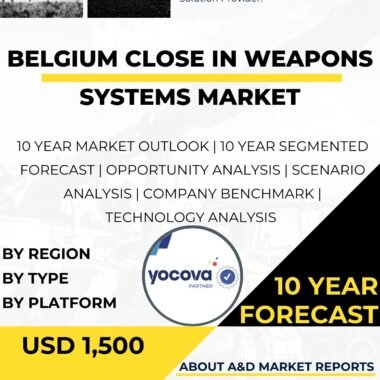Description
The tactical missiles market in Singapore has experienced significant growth in recent years, driven by the country’s commitment to enhancing its defense capabilities, bolstering its armed forces, and addressing the evolving security challenges in the region. Tactical missiles are precision-guided weapons designed for short and medium-range engagements, offering a critical edge in modern warfare. This article provides an overview of the Singapore tactical missiles market, including key drivers, major players, applications, challenges, and future prospects.
Singapore’s focus on defense modernization and ensuring national security has been a primary driver for the growth of the tactical missiles market. As a small nation with a strategic location in Southeast Asia, Singapore faces unique security challenges, including potential threats to its territorial waters, airspace, and critical infrastructure. Acquiring advanced tactical missiles allows the country to strengthen its defense capabilities and respond effectively to security threats.
The evolving security landscape and the need to maintain regional stability have also contributed to the growth of the tactical missiles market in Singapore. The country’s participation in international peacekeeping and security efforts further emphasizes the importance of possessing modern and versatile missile systems. Tactical missiles provide Singapore with the ability to deter potential adversaries and contribute to regional security initiatives.
Singapore’s modernization efforts for its armed forces have played a crucial role in driving the demand for tactical missiles. As the country continues to invest in state-of-the-art military equipment and technologies, there is a growing need for advanced missile systems to complement other defense assets. Tactical missiles offer the precision and effectiveness required for various military operations, including defense against enemy forces and protection of vital assets.
Several international defense companies are prominent players in the Singapore tactical missiles market. These companies offer a wide range of tactical missile systems, including surface-to-surface and surface-to-air variants, designed to cater to diverse requirements. Collaborating with international players enables Singapore to access cutting-edge missile technologies and benefit from their expertise in design, development, and integration.
Furthermore, Singapore’s indigenous defense industry has been actively contributing to the growth of the tactical missiles market. Local defense companies have played a significant role in the development and production of missile components and subsystems. The growth of the domestic defense industry not only enhances Singapore’s self-reliance but also contributes to the overall growth of the tactical missiles market in the country.
The applications of tactical missiles in Singapore are diverse and extend beyond traditional military operations. In addition to their use in national defense, tactical missiles serve as crucial assets in supporting homeland security and border control efforts. These missiles can provide effective deterrence against potential threats, protect key installations, and enhance the country’s overall security posture.
Moreover, tactical missiles play a vital role in maritime security, enabling the Singapore Armed Forces to safeguard territorial waters and respond to maritime threats effectively. The integration of tactical missile systems with maritime patrol and surveillance assets enhances Singapore’s maritime domain awareness and contributes to the protection of vital sea lanes.
However, the tactical missiles market in Singapore also faces certain challenges. One significant concern is the high cost associated with acquiring and maintaining advanced missile systems. Tactical missiles are sophisticated weapons that demand substantial investment in research, development, and production. Additionally, ongoing expenditures for missile maintenance, training, and infrastructure can pose budgetary constraints.
Ensuring interoperability with other defense systems is another critical challenge. The integration of tactical missiles with existing military assets and communication networks requires careful planning and coordination. Singapore’s defense forces must ensure seamless communication and coordination between different systems to optimize the effectiveness of tactical missile deployments.
Furthermore, export regulations and international arms control agreements can impact the market for tactical missiles in Singapore. The country must navigate the complex landscape of arms trade regulations to ensure compliance with international norms while meeting its defense requirements.
Looking ahead, the future prospects for the Singapore tactical missiles market remain positive. As the country continues to prioritize its defense modernization efforts and regional security commitments, the demand for advanced tactical missiles is expected to grow. The ongoing collaboration with international defense companies and the growth of the domestic defense industry will further fuel market expansion.
Moreover, technological advancements in missile systems, such as improved guidance and propulsion technologies, present new opportunities for the tactical missiles market. The development of smart and networked missile systems can enhance precision, reduce collateral damage, and improve overall operational capabilities.
In conclusion, the tactical missiles market in Singapore has experienced significant growth, driven by the country’s commitment to defense modernization and addressing regional security challenges. The presence of international players and the growth of the domestic defense industry have contributed to the market’s expansion. Tactical missiles find diverse applications, including national defense, maritime security, and homeland protection. While challenges related to cost, interoperability, and export regulations exist, the market’s future appears promising, driven by Singapore’s focus on defense modernization and technological advancements in missile systems.”




